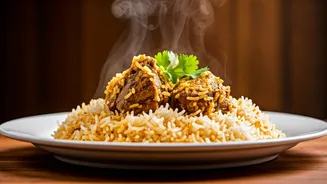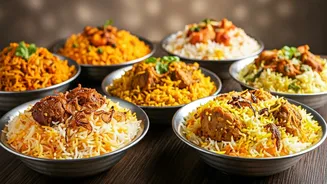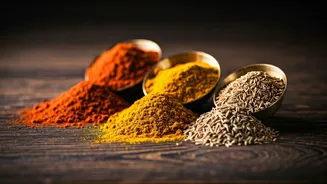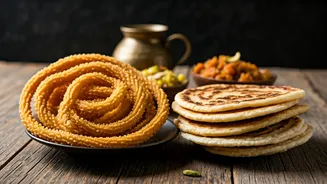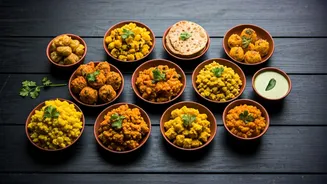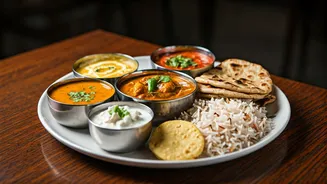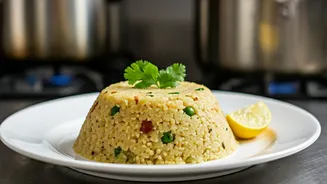Aromatic Biryani Bliss
Biryani, a dish of Mughal origin, has become an integral part of South Indian cuisine. The regional variations are vast and delightful. Hyderabad Biryani, for
instance, is known for its fragrant, spiced rice layered with tender meat. The secret lies in the slow cooking process, which infuses the rice with the flavors of the marinated meat. In contrast, Thalassery Biryani from Kerala uses a unique blend of spices and a special type of rice, creating a distinct flavor profile. Each region boasts its own biryani style, making it a diverse and exciting dish to explore. The dish is not only a culinary treat but also a symbol of hospitality, often served at celebrations and gatherings across South India. The use of aromatic spices like saffron and cardamom elevates the dining experience, making each mouthful a celebration of flavor and tradition.
Lemon Rice Zest
Lemon Rice, or Chitranna, is a South Indian staple, celebrated for its simplicity and refreshing taste. This dish is prepared by tempering cooked rice with mustard seeds, lentils, and curry leaves, and then infusing it with the bright tang of lemon juice. The preparation is quick, making it a popular choice for a light lunch or as a side dish. The dish's appeal lies in its simplicity; it is a straightforward yet satisfying meal. Variations exist where ingredients like peanuts, cashews, or vegetables are added to enhance the texture and flavor. Lemon rice is also a common offering during religious festivals and ceremonies, symbolizing purity and auspiciousness. The dish's vibrant appearance and zesty aroma make it an instant appetite-whetting treat.
Tamarind Rice Temptation
Tamarind Rice, or Pulihora, is another beloved dish that showcases the diverse flavors of South India. This dish is characterized by its tangy and slightly sweet taste derived from the tamarind pulp used in its preparation. The process involves cooking rice with a tamarind paste that is infused with spices, creating a dish that is both complex and comforting. The dish typically features a tempering of mustard seeds, lentils, and dried chilies to enhance the flavors and provide a crunchy texture. This dish is often prepared during festivals and special occasions, representing a blend of tradition and culinary skill. Its ability to last for several days makes it a practical dish, often packed for long journeys. Each bite of tamarind rice encapsulates the essence of South Indian cuisine.
Curd Rice Comfort
Curd Rice, or Thayir Sadam, is a cooling and soothing dish that is commonly enjoyed throughout South India, especially during hot weather. It is essentially cooked rice mixed with creamy curd or yogurt and tempered with mustard seeds, curry leaves, and sometimes ginger and green chilies. The dish is simple to make and is praised for its cooling effect. It is considered a digestive aid and is often served at the end of a meal. Variations include adding fruits, vegetables, or finely chopped coriander to enhance the taste and texture. In many South Indian homes, curd rice is an everyday meal due to its ease of preparation and its suitability for all age groups. This dish is a symbol of simplicity and nourishment.
Coconut Rice Delight
Coconut Rice, or Thengai Sadam, offers a delightful combination of coconut and rice. The dish is made by cooking rice with fresh coconut milk or grated coconut, providing a rich, creamy texture and a subtle sweetness. It is often tempered with mustard seeds, urad dal, and curry leaves for added flavor and aroma. The dish is a popular choice for festivals and celebrations, often served with chutneys and curries. The use of fresh coconut gives the dish a unique, tropical flavor, making it a favorite among those who enjoy coconut. It is versatile and can be served as a main dish or a side, representing the flavors of coastal South India.
Tomato Rice Treat
Tomato Rice, or Tomato Bath, is a popular dish that features the vibrant tanginess of tomatoes. This dish is made by cooking rice with a tomato-based gravy, spiced with aromatic ingredients like onions, ginger, and garlic. The preparation usually involves sautéing the tomatoes and spices to form a flavorful base, then adding the rice. It is a quick and flavorful meal option that is often enjoyed for breakfast or lunch. Many families have their own unique variations, adding vegetables or different spices to customize the flavor. This dish symbolizes the ability to turn simple ingredients into a satisfying meal. Tomato Rice is a testament to how humble ingredients can create a symphony of flavors.
Vegetable Biryani Variety
Vegetable Biryani offers a vegetarian version of the classic biryani, packed with an assortment of vegetables and fragrant spices. This dish uses rice, which is layered with a medley of fresh vegetables such as carrots, potatoes, beans, and peas. The vegetables are cooked with aromatic spices, which allows the flavors to meld together. It's often slow-cooked to infuse the rice with the vegetable and spice flavors. The preparation of vegetable biryani varies from region to region, with each area adding its own unique spice blend. The dish is a testament to how vegetarian cuisine can be flavorful and satisfying, making it a favorite among vegetarians and non-vegetarians alike. Vegetable biryani is a versatile and adaptable dish.
Pongal's Savory Charm
Pongal is a South Indian dish traditionally prepared during the harvest festival of Pongal. It comes in two primary forms: sweet Pongal and savory Pongal. Savory Pongal, also known as Ven Pongal, is made with rice and lentils, cooked with ginger, green chilies, and cumin seeds. The dish is tempered with ghee, which enhances the flavors and adds a rich aroma. Ven Pongal is often served with a variety of chutneys and sambar. It is considered a comforting and wholesome dish, commonly enjoyed for breakfast. It symbolizes prosperity and is an integral part of South Indian culture. The dish's simplicity and warmth make it a beloved dish.
